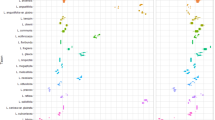Abstract
The development of the seed coat ofSimmondsia, whose relationships are extremely problematic, is documented, and its structure is compared to those of putatively related families Euphorbiaceae and Buxaceae. InSimmondsia, the young seed coat is composed of (1) the palisadal exotesta, (2) the thick aerenchymatous mesotesta which is further differentiated into the outer and the inner tissue of mesotesta, and the undifferentiated (3) endotesta and (4) tegmen. At maturity, only the palisadal exotesta composed of thick-walled and prismatic cells, as well as the outer tissue of mesotesta composed of elongate, thick-walled cells, are persistent, while all the remainder is crushed. These distinctive structural features of the exo- and mesotesta inSimmondsia are not found in Euphorbiaceae, but prevalent in Buxaceae. Evidence from seed coat anatomy and other sources supports the view thatSimmondsia has close affinities with Buxaceae, and be placed as a distinct family along with Buxaceae in Buxales.Simmondsia has 2n=52 as a tetraploid ofx=13, and probably represents a taxon adapted to desert areas by polyploidization in the order.
Similar content being viewed by others
References
Behnke, H.-D. 1982. Sieve-element plastids, exine sculpturing, and the systematic affinities of the Buxaceae. Pl. Syst. Evol.139: 257–266.
Bouman, F. 1984. The ovule.In B.M. Johri, ed., Embryology of Angiosperms, pp. 123–157. Springer-Verlag, Berlin.
Suchmann, S.L. 1987. Floral biology of jojoba (Simmondsia chinensis), an anemophilous plant. Desert Plants8: 111–124.
Carlquist, S. 1982. Wood anatomy of Buxaceae: correlations with ecology and phylogeny. Flora172: 463–491.
Corner, E.J.H. 1976. The Seeds of Dicotyledons. 2 vols. Cambridge University Press, Cambridge.
Cronquist, A. 1981. An Integrated System of Classification of Flowering Plants. Columbia University Press, New York.
— 1988. The Evolution and Classification of Flowering Plants. 2nd edn. The New York Botanical Garden, New York.
Dahlgren, G. 1989. The last Dahlgrenogram. System of classification of the dicotyledons.In Kit Tan, ed., Plant Taxonomy, Phytogeography and Related Subjects. The Davis and Hedge Festschrift, pp. 249–260. Edinburgh University Press, Edinburgh.
Dahlgren, R. 1983. General aspects of angiosperm evolution and macrosystematics. Nord. J. Bot.3: 119–149.
Drinnan, A.N., P.C. Crane, E.M. Friis andK.R. Pedersen. 1991. Angiosperm flowers and tricolpate pollen of buxceous affinity from the Potomac group (mid-Cretaceous) of eastern North America. Amer. J. Bot.78: 153–176.
Erdtman, G. 1966. Pollen morphology and plant taxonomy. Angiosperms. (An Introduction to Palynology I). Hafner, New York.
Köhler, E. andP. Brückner. 1983. Zur Pollenmorphologie und systematischen Stellung der GattungSimmondsia Nutt. Wiss. Z. Friedrich-Schiller-Univ. Jena, Math.-Naturwiss. Reihe.32: 945–955.
Lee, C.W. andR.A. Sherman. 1985. Meiosis in jojoba,Simmondsia chinensis. Israel J. Bot.34: 1–6.
Löve, A. 1978.In IOPB chromosome number reports LXII. Taxon27: 522.
Melikian, A.P. 1968. On the position of the families Buxaceae and Simmondsiaceae in the system. Bot. Zhurn.53: 1043–1047. (In Russian with English summary).
Nowicke, J.W. andJ.J. Skvarla. 1984. Pollen morphology and the relationships ofSimmondsia chinensis to the order Euphorbiales. Amer. J. Bot.71: 210–215.
Oginuma, K. andM. Nakata. 1988. Cytological studies on phanerogams in southern Peru. I. Karyotype ofAcaena ovalifolia. Bull. Natl. Sci. Mus., Ser. B,14: 14: 53–56.
Raven, P.H. 1975. The bases of angiosperm phylogeny: cytology. Ann. Missouri Bot. Gard.62: 724–764.
—,D.W. Kyhos andA.J. Hill. 1965. Chromosome numbers of spermophytes, mostly Californian. Aliso6: 105–113.
Rost, T.L., A.D. Simper, P. Schell andS. Allen. 1977. Anatomy of jojoba (Simmondsia chinensis) seed and the utilization of liquid wax during germination. Econ. Bot.31: 140–147.
Scogin, R. 1980. Serotaxonomy ofSimmondsia chinensis (Simmondsiaceae). Aliso9: 555–559.
Stebbins, G.L. andJ. Major. 1965. Endemism and speciation in the California flora. Ecol. Monogr.35: 1–25.
Takhtajan, A. 1986. Floristic Regions of the World. University of California Press, Berkeley.
— 1987. Systema Magnoliophytorum. Nauka, Leningrad. (in Russian).
Tanaka, R. 1971. Types of resting nuclei in Orchidaceae. Bot. Mag. Tokyo84: 118–122.
— 1980. The karyotype.In H. Kihara, ed., Plant Genetics. Vol. 1, pp. 335–358. Shokabo, Tokyo. (in Japanese).
Thorne, R.F. 1981. Phytochemistry and angiosperm phylogeny: a summary statement.In D.A. Young and D.S. Seigler, ed., Phytochemistry and Angiosperm Phylogeny, pp. 233–295. Praeger Sci., New York.
— 1983. Proposed new realignments in the angiosperms. Nord. J. Bot.3: 85–117.
— 1989. Phylogeny and phytogeography. Rhodora91: 10–24.
— 1992. An updated phylogenetic classification of the flowering plants. Aliso13: 365–389.
Vaughan, J.G. 1970. The Structure and Utilization of Oil Seeds. Chapman & Hill, London.
Webster, G.L. 1987. The saga of the spurges: a review of classification and relationships in the Euphorbiales. Bot. J. Linn. Soc.94: 3–46.
Wiger, J. 1935. Embrylogical studies on the families Buxaceae, Meliaceae, Simarubaceae and Burseraceae. Thesis, Lund.
Wunderlich, R. 1967. Some remarks on the taxonomic significance of the seed coat. Phytomorphology17: 301–311.
Author information
Authors and Affiliations
Rights and permissions
About this article
Cite this article
Tobe, H., Yasuda, S. & Oginuma, K. Seed coat anatomy, karyomorphology, and relationships ofSimmondsia (Simmondsiaceae). Bot Mag Tokyo 105, 529–538 (1992). https://doi.org/10.1007/BF02489427
Received:
Accepted:
Issue Date:
DOI: https://doi.org/10.1007/BF02489427




